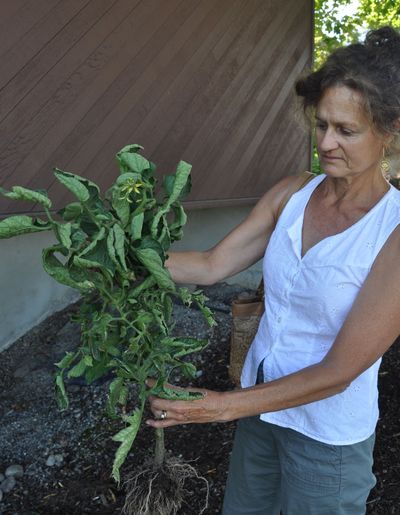Some leaf-curl problems can be corrected

After last week’s column on the impact of last October’s cold snap, I heard from a number of folks asking what was going on with their tomatoes, peppers, basil, melons and cucumbers given the cool, wet weather.
Most of the plants you were asking about were vegetables we traditionally classify as warm-season crops. As such, they need warm weather to grow properly. They didn’t get any of that in June.
Bean, melon, cucumber and corn seeds that didn’t come up probably rotted in the ground. Some of you caught this early enough to reseed and may get a late crop if we get a long fall.
Plants like basil, cucumber, melons and peppers that looked lush and green when they were planted slowly turned yellow and quit growing as the cold weather wore on. All of these need especially warm soil to grow properly. They can take short doses of cold weather but when it drags on for weeks they become stunted. Once this happens, there is little hope that plants will recover enough to begin growing. The nice thing about basil is that you can seed it now and still get a nice crop in late August.
Tomatoes have reacted to the cold and then the heat by cupping their leaves upward and then rolling the edges in on themselves. The leaves then become thick and leathery but do not change color. This condition is called physiological leaf roll. The severity of this condition depends on the cultivar of tomato, with taller-growing varieties more likely to be affected than bush types. Inconsistent moisture levels in the soil during the cold-to-hot transitions and hard pruning can also contribute to the problem.
This condition is easily confused with curly top virus, a common disease in Eastern Washington. The virus is carried by sucking insects, particularly the beet leaf hopper, and also affects beets, beans, cucumbers, spinach, squash and peppers. Plants affected by curly top will roll their leaves upward, twist them sharply and take on a peculiar dull yellow color. The leaflet stems turn purple and the plant is often stunted or dies as roots die in response to the virus.
Plants affected by physiological leaf roll generally resume normal growth when the growing conditions improve and will produce normally. Curly top virus-affected plants won’t recover, and controlling the leaf beetle has proved to be ineffective. The best way to reduce the problem is plant resistant varieties of tomato. Because the leaf beetle prefers to work in bright sunlight, shading plants can reduce beetle visits and potential infection by the virus.
Make sure gardens get watered evenly. Waiting too long between waterings affects the growth of many vegetables: Potatoes get knobby, tomatoes can develop blossom end rot on the bottom of the fruit, and beans can produce short pods.